Biofuels and CII: your questions answered
Biofuels are both versatile and widely available, providing many benefits to shipowners. They can be used on most ship types, with no significant modification needed, and can be blended with fossil fuels for an immediate reduction in CO2 emissions.
However, their full benefit is best judged from a well-to-wake (WtW) approach, whereas IMO’s Carbon Intensity Indicator (CII) is defined on a tank-to-wake (TtW) basis. This has led the IMO to approve "Interim guidance on the use of biofuels under regulations 26, 27 and 28 of MARPOL Annex VI," also known as Circular MEPC.1/Circ.905.
MEPC.1/Circ.905 aims to assist with the calculation for IMO DCS and CII for ships using biofuels. Bureau Veritas is here to answer key questions on this guidance.
-
How are emissions from biofuels currently calculated for CII?
The CII is defined in the IMO instruments on a TtW basis. Its reference values and the ship's A to E rating boundaries have been established from the fuel consumption collected for 2019. The fuel consumption was then transformed into CO2 emissions using the EEDI 2018 guidelines' Cf emission factors (MEPC 308(73)) and the rating boundaries are defined using a statistical distribution for a given ship category.
The Cf is explicitly defined as TtW, and not accounting for the WtW life cycle of fuels may be detrimental to certain biofuels. -
What led to Circular MEPC1./Circ.905’s acceptance?
Some delegations at IMO have called for greater recognition of the importance of biofuel as a lever to decarbonization. They are asking for more clarity and guidance from the IMO to ensure biofuels get a level playing field in IMO DCS reporting and attained CII calculation.
IMO’s comprehensive guidelines on the life cycle greenhouse gas (GHG) intensity of marine fuels (LCA guidelines) have yet to be finalized. But in the meantime, these delegations have stressed biofuels’ ability to reduce GHG emissions in the short term, their current availability, and their ability to assist in CII compliance. Some shipowners are already prepared to invest in accommodating biofuel bunkering, and delegates say such investments to improve compliance performance should be incentivized. -
What are the key points and requirements in Circular MEPC.1/Circ.905?
Circular MEPC.1/Circ.905 contains:
- Reporting requirements for ships using biofuels.
- An interim simplified method until a Cf reflecting its WtW GHG emissions and removals based on the LCA Guidelines is established.
It maintains that:
- Biofuels that have been certified as sustainable through an international certification system should be promoted.
- Biofuels should be eligible according to that certification when they achieve a WtW GHG emissions reduction of at least 65% compared to fossil MGO of a 94gCO2e/MJ emissions intensity (i.e., not exceeding an emissions intensity of 33gCO2e/MJ).
- Biofuels blends should be accounted for based on the weighted average of the Cf for the respective amount of fuel by energy.
-
Which international sustainability certification schemes are accepted?
In a footnote, IMO interim Guidelines contained in Circular MEPC.1/Circ.905 make explicit reference to:
- The ICAO's Approved Sustainability Certification Schemes
- The CORSIA Sustainability Criteria (chapter 2) for CORSIA Eligible Fuels
Nevertheless, other international certification schemes (e.g., ISSC EU) are likely to be accepted, though subject to Flag agreement.
-
When did Circular MEPC.1/Circ.905 enter into effect?
The date of application for Circular MEPC.1/Circ.905 was 1 October 2023. Biofuels used from that date could be accounted and reported in IMO DCS providing they comply with the provisions of the Circular and are duly declared in the Ship Energy Efficiency Management Plan (SEEMP) Part II and Part III, as appropriate.
N.B.: Flag Administrations may have different policies that allow crediting of the use of biofuels from an earlier date (e.g., beginning of the 2023 calendar year). -
Can a biofuel certified as complying with the sustainability aspects of Circular MEPC.1/Circ.905 be assigned a Cf value of “0” for use in IMO DCS and CII? Should it instead equal the certified WtW GHG emissions value multiplied by its LCV?
For the purpose of regulations 26, 27, and 28 of MARPOL Annex VI:
- The Cf value shall be calculated on the basis of the value of the fuel’s WtW GHG emissions (expressed in gCO2eq/MJ) according to the Proof of Sustainability (PoS) multiplied by its Lower Calorific Value (LCV, expressed in MJ/g) for the corresponding amount of fuel consumed by the ship.
Please refer to examples of biofuel and biofuel blends Cf calculations in Annex I.
-
How are blended biofuels calculated and accounted for?
The Cf of blended biofuels is to be based on the weighted average of the Cf for the amount of fuel by energy.
Please refer to examples of biofuel and biofuel blends Cf calculations in Annex I.
-
Does Circular MEPC.1/Circ.905 apply to biogas?
This is not explicitly referenced in Circular MEPC.1/Circ.905 and is therefore subject to the agreement of the Flag.
-
What supporting documents must be submitted for the verification of reported biofuel use and consumption?
For the verification of biofuel use and consumption, the following must be provided:
- A PoS, or a similar document from a recognized scheme. This document must indicate the WtW GHG emissions value of the fuel mentioned, expressed in gCO2eq/MJ.
- The LCV of the specific biofuel, which is expressed in MJ/g, in the form of a laboratory test result or another equivalent document.
- The bunker delivery notes (BDN), and a document confirming the biofuel’s properties, such as a certificate of fuel quality. The supplier will provide these to the ship at each bunkering operation.
-
Do I need to revise and submit Part II/III of the SEEMP for verification?
Yes, you will need to revise the SEEMP Part II and SEEMP Part III, as appropriate to include, as appropriate:
- The type of fuel intended to be used
- The proper justification and supporting documentary evidence for its assigned Cf, in accordance with the 2022 Guidelines for the development of a SEEMP (Resolution MEPC.346(78))
-
How should biofuels as a fuel or biofuel blends be reported under IMO DCS?
Without a specific reporting category from the IMO1 or specific instruction from the Flag, biofuels should be reported under "Other," specifying a user-defined description and Cf value.
Fuel oil consumption (t) Other (biofuel - MEPC.1/Circ.905) (Cf: [Value] ) For blends, the Guidelines mention the overall value that must be determined (based on the weighted average of the Cf for the respective amount of fuel by energy). Therefore, it is assumed that the biofuel blend data must be entered as a single product, and thus a similar approach to the above may be used to indicate the type of blend.
1Reference: MEPC 79/6/1 para.25 & MEPC 81/6 para.13.2
-
How could this impact my ship’s CII rating?
Please refer to Annex II for impact studies on 5 vessel types:
- Container ships
- Tankers
- Bulk carriers
- Cruise ships
- Ro-ro ships
Annex I: Example calculations
Example of a PoS emitted by ISCC according to EU Renewable Energy Directive (EU 2018/2001 – RED II) Requirements
see here
-
Case 1: A ship receiving 100mt of 100% biofuel FAME (B100)
- As per the PoS, the GHG emission intensity of the biofuel equals 14.9gCO2eq/MJ and therefore falls below the 33gCO2/MJ threshold set by IMO Circular.
- The LCV of the value can be calculated thus:
LCV = 3,960,763MJ / 107,045kg = 37MJ/kgfuel = 0.037MJ/gfuel
- Cf of the biofuel therefore equals:
0.037 x 14.9 = 0.551gCO2/gfuel = 0.551tCO2/tfuel
Three decimals are used, as per the 2022 Guidelines on the method of calculation of the attained EEDI for new ships (Resolution MEPC.364(79)).
- Finally, in DCS reporting, this calculated Cf (0.551tCO2/tfuel in this example) and the quantity of biofuel bunkered (in this example 100mt) should be filled in “Other” column, as per the 2022 Guidelines for the development of a SEEMP (Resolution MEPC.346(78)).
- As per the PoS, the GHG emission intensity of the biofuel equals 14.9gCO2eq/MJ and therefore falls below the 33gCO2/MJ threshold set by IMO Circular.
-
Case 2: A ship receiving 550mt of 24% biofuel FAME (B24)
- In this case, the BDN mentions a quantity of B24 delivered of 550mt. Attached with this, the certificate of quality of the fuel mentions a FAME content of 24%.
- The PoS received leads to a Cf of 0.551tCO2/tfuel for the biofuel part of the blend (refer to Case 1 for calculation details); assuming that the quantity delivered is ≥ 130mt of biofuel.
- In this example, the grade of the VLSFO residual blend component is referenced in the BDN as a RMG380 grade. It thus corresponds to HFO, according to the 2022 Guidelines on the method of calculation of the attained EEDI for new ships (Resolution MEPC.364(79)).
The corresponding Cf of the VLSFO blend component equals 3.114tCO2/tfuel.
- The Cf for the blend shall be calculated as per the below:
LCV Fuel Energy Energy fraction of
the blendCf Blend weighted by energy MJ/kg t MJ % tCO2/tfuel FAME 37.000
130
4,810,000
22%
0.551
0.122
VLSFO 40.200
420
16,884,000
78%
3.114
2.424
2.546 5. Finally, in DCS reporting, this calculated Cf (in this example 2.546tCO2/tfuel) and the quantity of biofuel B24 bunkered (in this example 550mt) should be filled in “Other” column, as per the 2022 Guidelines for the development of a SEEMP (Resolution MEPC.346(78)).
- In this case, the BDN mentions a quantity of B24 delivered of 550mt. Attached with this, the certificate of quality of the fuel mentions a FAME content of 24%.
Annex II: IMO considerations for biofuels and impact study on biofuels CII rating
-
IMO considerations for biofuels
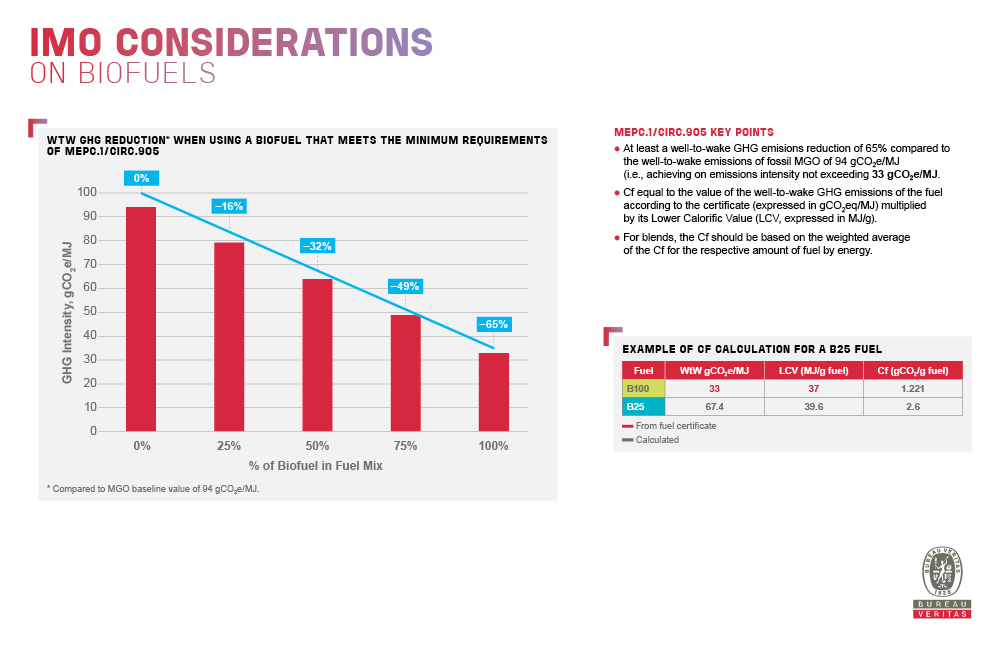
-
Bulk carrier
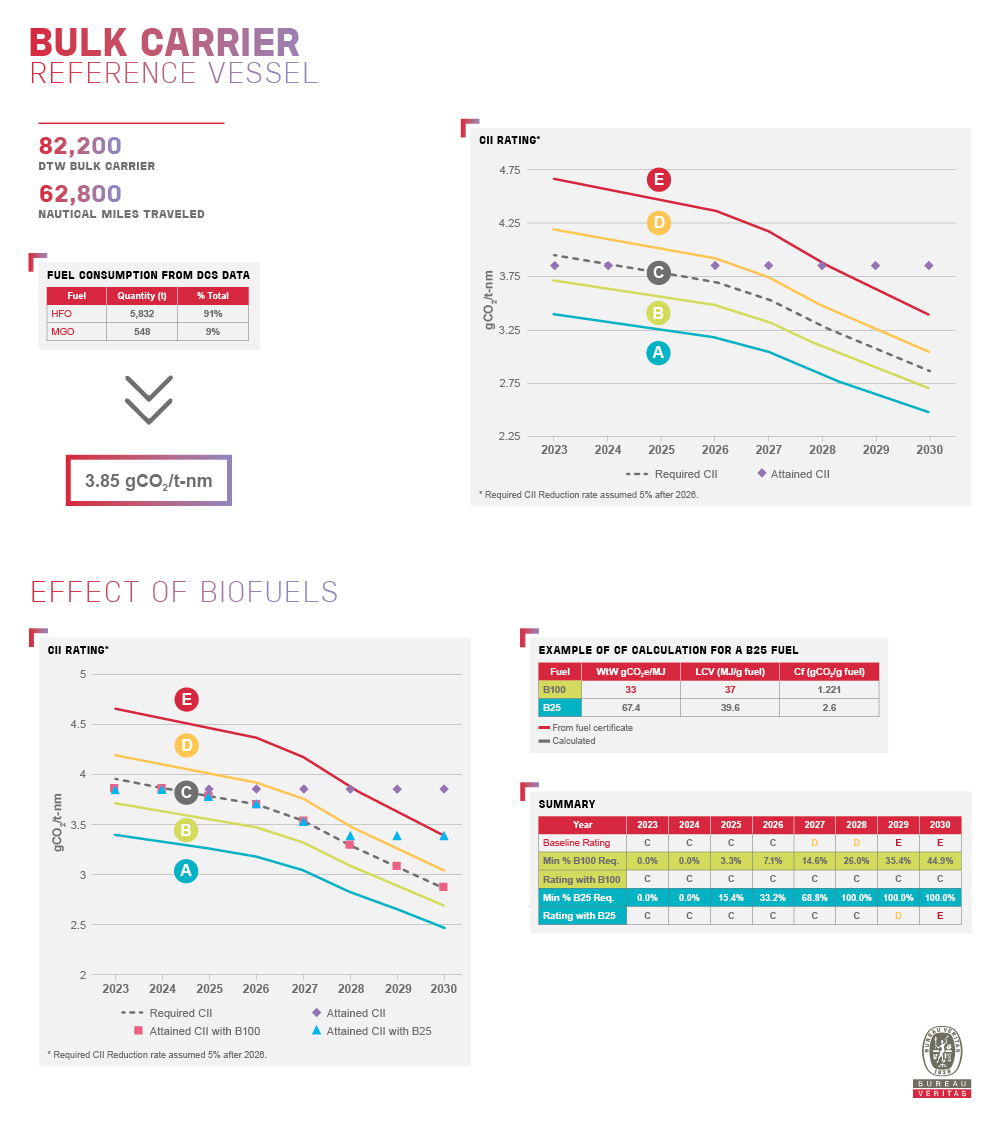
-
Chemical tanker

-
Container ship
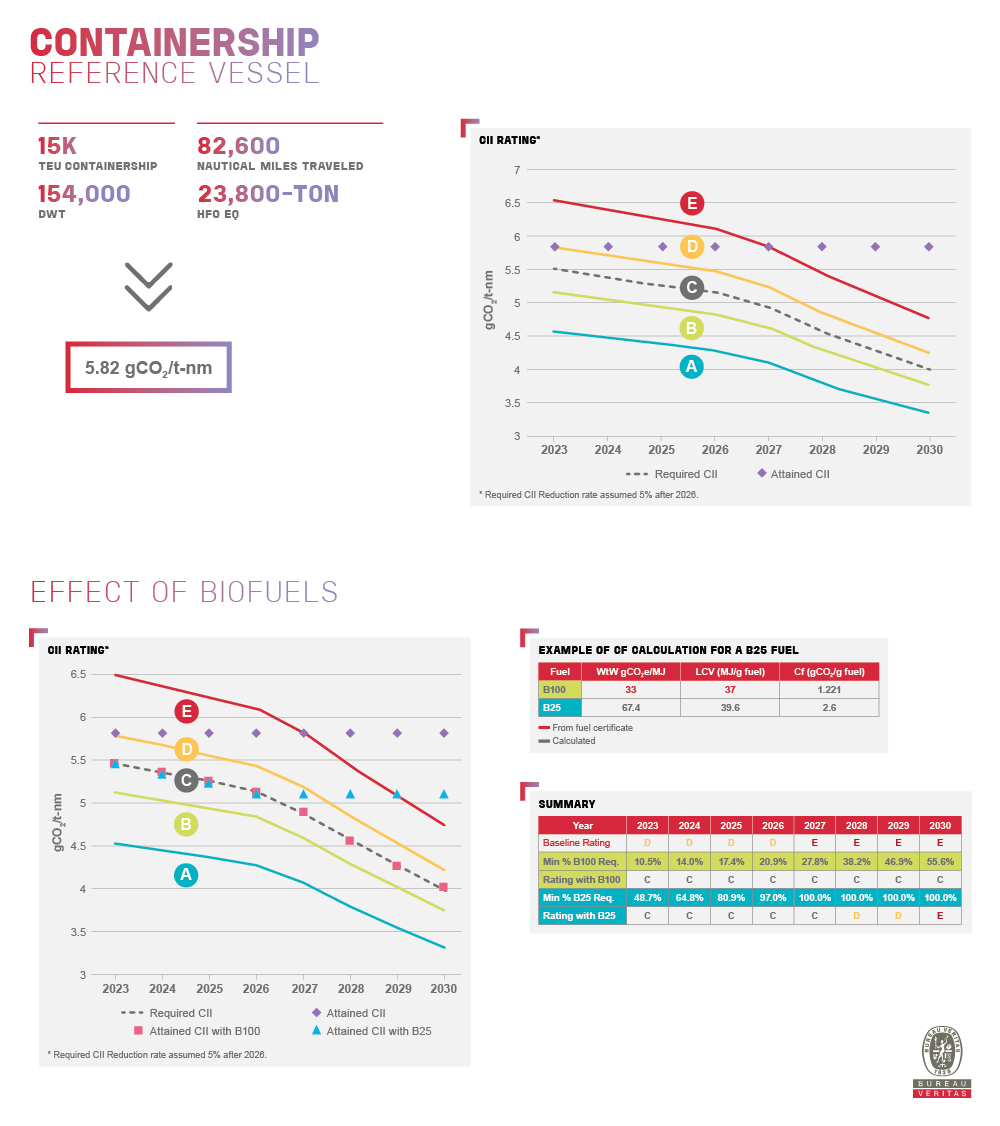
-
Cruise Vessel
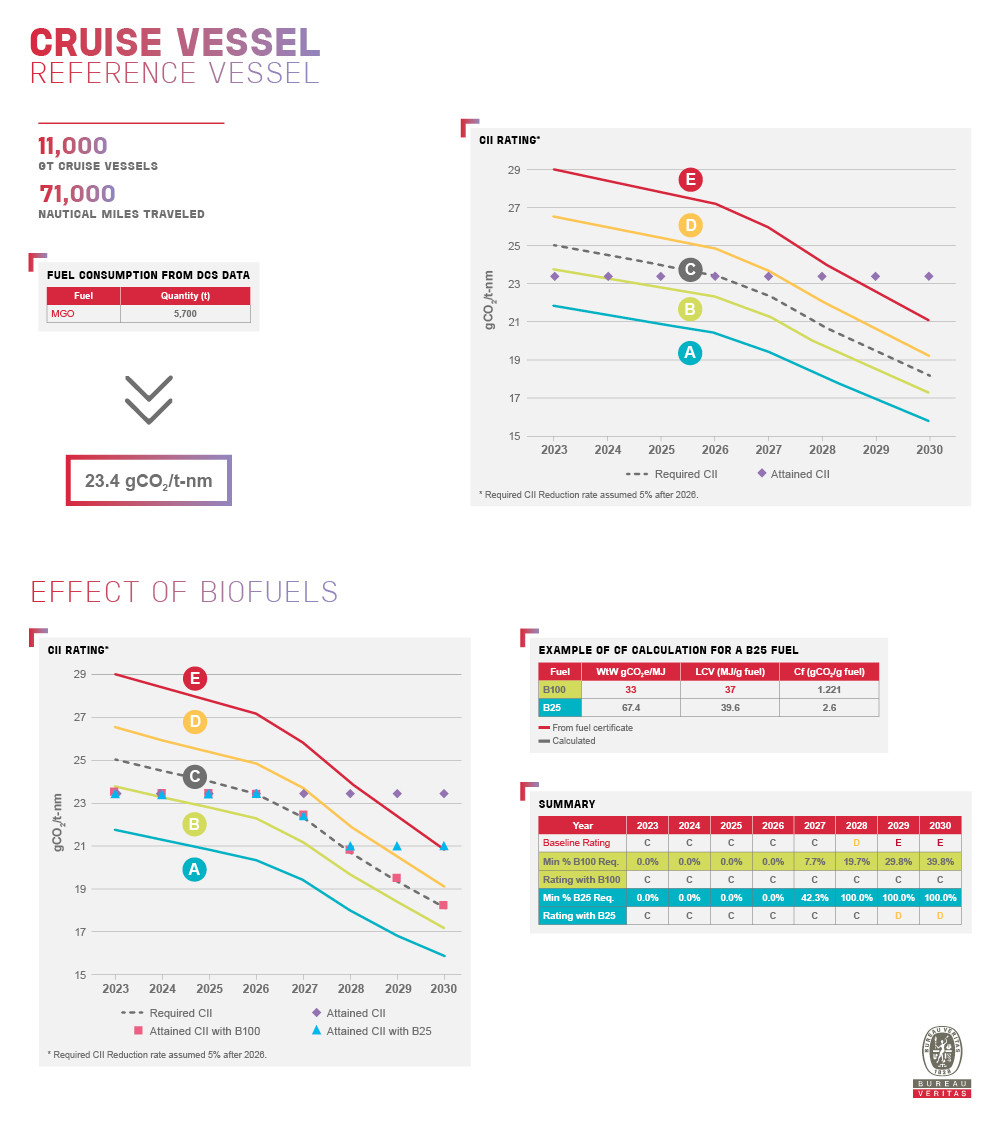
-
Ro-ro vessel
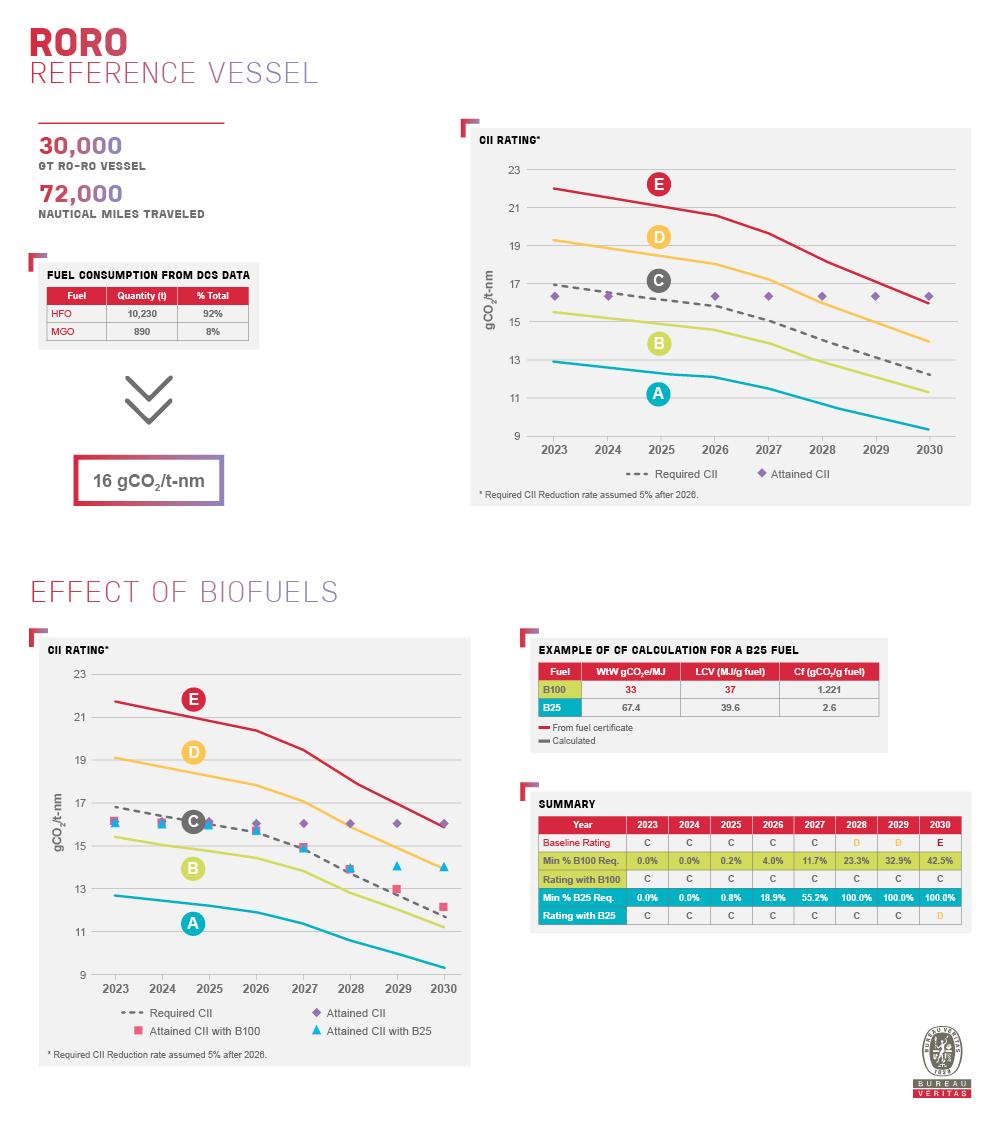
Bureau Veritas has developed significant expertise to address fuel certification, notably leveraging our track record in ISCC or RedCert schemes. Further to this, we can also support fuel quality assessments with the help of Verifuel’s fuel experts.
We’re by your side to help you navigate the decarbonization challenge. As IMO guidelines and requirements evolve, our experts are here to explain what these changes mean for your vessel, so you can make the right decisions.











